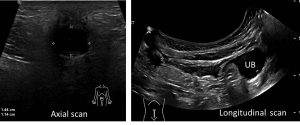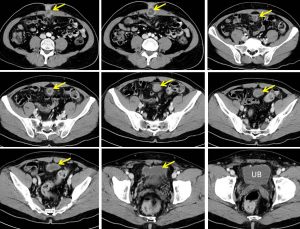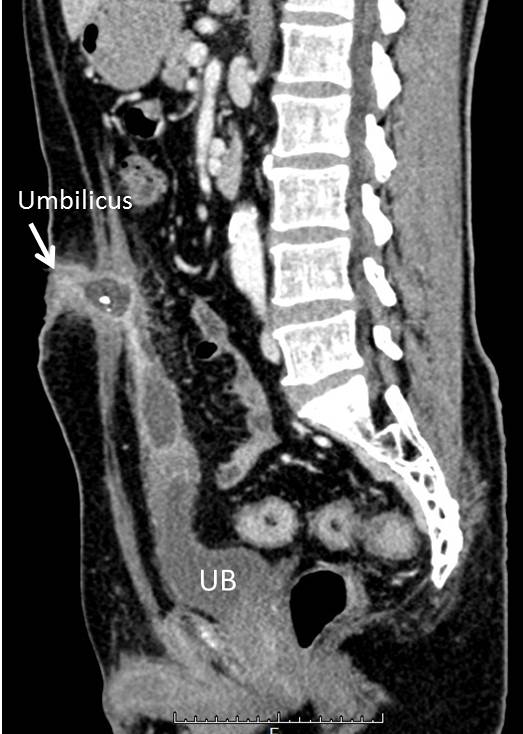Clinical:
- A 55 years old man
- No known medical illness
- Presented with umbilical discharge for 3 weeks
- Feeling feverish on and off
- Having pain for the past few days
- Clinically pus discharge seen from umbilibus

Ultrasound findings:
- There is a rounded hypoechoic subcutaneous lesion with internal echoes seen immediately posterior to the umbilical opening, measuring at 2.4 x 2.1cm.
- It appears continuous to an intra-abdominal component, which appears tubular and elongated. It can be seen coursing along the posterior aspect of the anterior abdominal wall until the urinary bladder dome region.
- No vascularity or calcification noted within either the subcutaneous or intra-abdominal component.
- The urinary bladder dome appears to have a thin cranial protrusion. Possible communication is visualised between this thin cranial urinary bladder protrusion and the tubular structure described above.

CT scan findings:
- There is an elongated fluid-filled tubular track appearing continuous from the dome of the urinary bladder until the umbilicus.
- It has irregular wall and measures at about 12.7cm in cranio-caudal length.
- A cystic lesion is seen at the umbilicus itself measuring at 2.2 x 1.8 x 1.9cm (AP x W x CC) which appears continuous with the tapered part of the track.
- Streakiness of the surrounding fat plane is also seen along the length of the track.
- Both kidneys are normal in size and location. Single ureters are seen bilaterally, which appear to insert normally into the urinary bladder. No urinary tract stone seen.
Diagnosis: Infected patent urachus.
Discussion:
- The urachus is a ductal remnant that arises embryologically, originating from the involution of the allantois and cloaca and extending between the bladder dome and the umbilicus.
- During normal gestational development, the urachus involutes and its lumen is obliterated, becoming the median umbilical ligament.
- Congenital urachal anomalies result from a failure of the developing urachus to completely obliterate its lumen.
- Four types urachal anomalies include: patent urachus (sometimes referred to as urachal fistula), urachal cyst, umbilical-urachal sinus, and vesicourachal diverticulum.
- Undetected urachal anomalies may cause abdominal and/or urinary complications as a result of chronic urinary stasis, inflammation, and infection, predisposing the patient to potential morbidity and malignanc.
- An infected urachal cyst can occur at any age.
